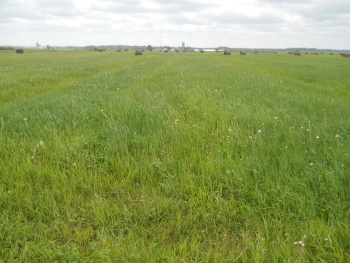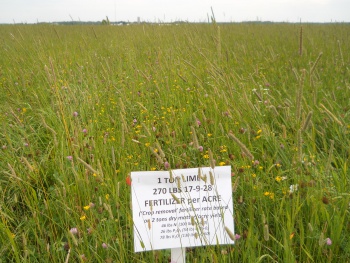For clover/grass hay, 13 pounds P2O5 and 39 pounds K2O is recommended for nutrient removal per ton of hay removed at 18 percent moisture. The fertilizer applied for the ‘nutrient removal rate’ was 270 pounds per acre of 17-9-28. The fertilizer rate of 460 pounds per acre of 10-22-24 for the build-up treatment was calculated for a yield goal of 2 tons per acre using an MSU soil test report for the field. Fifty pounds of actual nitrogen per acre was included with both the nutrient removal and build-up fertilizer treatments based on an early visual evaluation of the legume stand, estimated at 15 percent at the time of soil sample collection. Lime and fertilizer were applied May 26 and 28. The July 24, 2015, MSU Extension Forage Field Day held in Rudyard, Michigan, included this demonstration as a tour stop.


Treatmeant 4: Nutrient removal fertilizer plus 1 ton lime per acre. Taken June 10, 2015 (left) and again July 24, 2015 (right).
On Aug. 13, 2015, yield checks were taken from windrowed hay in each treatment strip. Two 5-foot sections of windrow were weighed from within each treatment and averaged. At each sampling site, the width of four windrows was measured to determine average windrow width. A hay sample for moisture content from each treatment was collected. All six moisture samples were dried by microwave and the moisture contents averaged to provide an estimate of 20.4 percent moisture for the entire demonstration. This simple yield check was not replicated, but provided a relative comparison of hay performance under the different treatments.
Yield check results:
- Treatment 1: No fertilizer, no lime – 1.81 tons dry matter (DM) per acre
- Treatment 2: No fertilizer, 1 ton lime – 1.33 tons DM per acre
- Treatment 3: Crop removal fertilizer, no lime – 2.60 tons DM per acre
- Treatment 4: Crop removal fertilizer plus 1 ton lime – 3.00 tons DM per acre
- Treatment 5: Build-up fertilizer, no lime – 2.64 tons DM per acre
- Treatment 6: Build-up fertilizer plus 1 ton lime – 3.48 tons DM per acre
By grouping fertilizer and lime treatments and comparing the average hay yields, the apparent impacts can be brought into focus:
- No fertilizer: 1.57 tons DM per acre
- Crop removal fertilizer rate: 2.80 tons DM per acre
- Build up fertilizer rate: 3.06 tons DM per acre
Yield results of lime and fertilizer treatments |
|---|
Lime treatment | No fertilizer | Fertilizer added |
|---|
No Lime | 1.81 DM per acre | 2.62 DM per acre |
Lime added | 1.33 DM per acre | 3.24 DM per acre |
Using a ballpark figure for fertilizer cost of $525 per ton, a very simple economic estimate can be made based on a single fertilizer/lime application and same-year harvest. Because the demonstration was not replicated and only one year of data is available, the economic estimate should be considered as a “snapshot” for this year and location only. It is anticipated the 2015 fertilizer/lime application will have additional yield impact in 2016, especially the build-up rate. Build up rates are expected to reach the critical level in three to four years, so they are not expected to break even in the first year.
- Crop removal fertilizer (272 pounds per acre 16.6-9.4-28.5) = $71.40 for fertilizer per acre + $7.50 spreading cost = total application cost of $78.90 per acre. This application resulted in an increased yield of 1.23 tons dry matter per acre above the unfertilized treatment. The hay value must equal $64.15 ($78.90/1.23) per ton of dry matter to break even in the first year.
- Build-up fertilizer (460 pounds per acre 10.0-22.3-23.7) = $120.75 for fertilizer per acre + $7.50 spreading cost = total application cost of $128.25 per acre. This application resulted in an increased yield of 1.49 tons dry matter per acre above the unfertilized treatment. The hay value must equal $86.07 ($128.25/1.49) per ton of dry matter to break even in the first year.
Summary
- On average, adding fertilizer resulted in a yield increase of 1.36 tons of dry matter per acre compared to adding no fertilizer.
- The full effects of lime as a surface application of 1 ton dolomitic lime per acre may not be discernable eight weeks after application.
- A very basic economic estimate indicates that the nutrient removal fertilizer application was economical when hay value exceeds $64.15 per ton of dry matter, and the build-up fertilizer application was economical when hay value exceeds $86.07 per ton of dry matter based on a single application/same-year harvest calculation and not considering potential yield improvement on second-year harvest.
- It is reasonable to expect the build-up treatment will have a positive impact on hay yield in the following year.
- The economic estimate offered does not include the positive impact of harvesting more hay from fewer acres. Additional cost savings could include less land rental, less fuel and expense of harvesting extra acres.
- The demonstration provided a good focal point for the July 24, 2015, MSU Extension Forage Field Day with highly visible difference in color and stand density between treatments. The follow-up yield check reinforces this impression.
Source:msu.edu